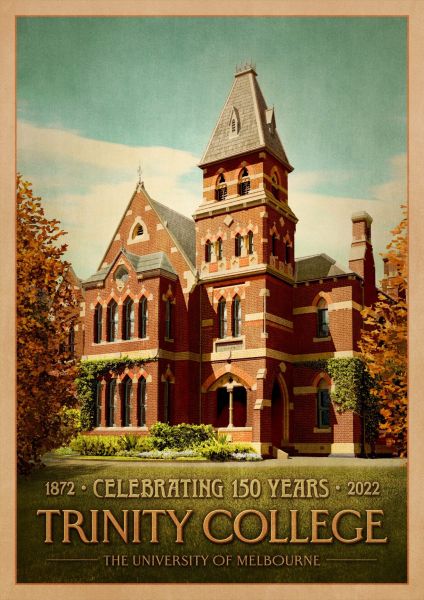The Story of Trinity College’s 150th Poster

The Story of Trinity College’s 150th Poster
‘If you’re not far away, you’re welcome to come in for a coffee, chat and look about the place. If nothing comes of it, you’re still up a coffee.‘
Trinity College to Harper & Charlie, 13 January 2019
This was the brief note, tapped out in speed via Instagram from Trinity College to Melbourne illustrator Harper & Charlie in early 2019, some three years before Trinity College would celebrate its 150th anniversary. Few could have seen the writing on the wall that within 12 months the project would all but seemingly have to be abandoned.
By late January 2020, the first cases of COVID-19 were being reported in Australia. By late March – faced with an uncertain but bleak economic forecast – the college adjusted to the rapidly deteriorating situation.
The inspiration behind Harper & Charlie’s trademark vintage style is that evocative period of graphic design between the 1920s and 1950s, so aptly represented by travel posters of the period depicting exciting, far-flung destinations around the globe. It was the era of early commercial flight, still in its infancy in the years following the First World War; of cruise liners ploughing their way across the seas, a veritable bridge between the comfortable and familiar and the foreign, daunting but exciting.
In Australia, it was also a period of renewed optimism after the war and the Great Depression at the beginning of the 1930s. Of course, there were rising spectres in Europe that would in the fullness of time cast long, dark shadows over that continent again, as well as our own. But new modes of transport, the increasing domestic availability of cars, motorcycles and national airlines – Qantas had been established in 1920 – meant travel was easier and more affordable than it had ever been.
And behind many of these posters was the hand of James Northfield, perhaps Australia’s best-known graphic artist of the twentieth century. In the 1930s and 1940s, Northfield’s illustrative work played a significant role in framing Australia as a tourist destination to international markets. His depictions of attractions along the country’s east coast, the Murray River, Blue Mountains, the Great Barrier Reef, Buchan Caves, and across to Western Australia, the ‘Red Centre’, and the North, conveyed an enticing vista of travel and places to be explored.
There was also a permanency about Northfield’s illustrations. Sure, there were thriving metropolises beckoning the would-be tourist. But in the country’s natural attractions there were a sentiment of wonder, a marvelling at features in the landscape that had seen out and been home to tens of thousands of years of Indigenous Australians before white settlement. Perhaps not immediately discerned, there is a timeless quality to his work.
‘On Monday next the new buildings of Trinity College, the erection of which has now been completed, will be formally opened for the use of students. The event, there is little doubt, will mark the commencement of a new era in the history of the college …‘ Argus, 14 June 1878
Trinity’s curator Ben Thomas, who conceived of the illustration’s commission, was led by his own experiences and recollections of walking on to our campus for the first time, saying: ‘Various aspects of these now accumulated thoughts swirled about me as I walked through Trinity’s gates for the first time, taking in the young faces I passed as I made my way across the campus and marvelled at the ornate forms of the campus’ heritage buildings. How many generations of students had passed through these same gates? Whose hands carelessly brushed the balustrade on the Clarke stairs only to burnish it smooth with the passage of time? What had they gone on to do, and what would those students in college now realise in the course of their own lives?’
Those same students are now already 10 years further down the road, achieving great things in so many walks of life.